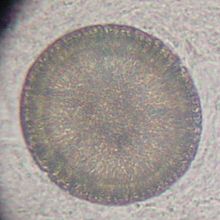Tapeworm Diseases of the Dog
In dogs (Canidae) a series of step tapeworms on which the clinical picture of the dog tapeworm disease can cause. The disease caused by the tripartite dog tapeworm , which is often simply referred to as "dog tapeworm", is particularly important for humans . Tapeworm diseases - like most roundworm infections - usually have no clinical symptoms in dogs. Since their clinical picture and treatment are very similar, they are presented together. In a multicenter study from 2019, an infestation frequency with tapeworms of 10.4% was determined in Europe and 7.5% in Germany.
Tapeworm species
The cucumber seed or pumpkin seed tapeworm ( Dipylidium caninum ) is the most common tapeworm in dogs and occurs worldwide. Occasionally this tapeworm also occurs in cats. Intermediate hosts are fleas or lice . The worm eggs are ingested by the flea larvae and develop into cysticercoids in them . By eating the fleas, these tapeworm stages get into the dog's intestines and develop into an adult tapeworm in 20 days. This is 10–70 cm long and 2–3 mm wide. When the fleas move to other dogs (or cats), it spreads further in the population. Diseases in humans, especially in children, are also rarely observed. This is called dipylidiasis .
The thick-necked tapeworm ( Hydatigera taeniaeformis ) is the second most common tapeworm in dogs. It also affects cats. Intermediate hosts are rats , mice and other rodents .
Representatives of the genus Taenia such as Taenia serialis (intermediate hosts mainly rabbits) and Taenia hydatigena (intermediate hosts ruminants, horses and real pigs ) parasitize in the small intestine. The quesen tapeworm ( Taenia multiceps ) occurs in dogs and foxes. Intermediate hosts are horses, cattle, sheep, goats, pigs, rabbits, deer and humans. In sheep, its fin causes "turning sickness" ( coenurosis ).
The tripartite dog tapeworm ( Echinococcus granulosus ) is one of the tapeworms that occurs less frequently in dogs in Central Europe, while the infestation is frequent in southern Europe. Artifacts and odd-toed ungulates , such as donkeys and pigs, serve as intermediate hosts . Infection can only occur through the consumption of raw offal from these intermediate hosts. The tripartite canine tapeworm is the cause of cystic echinococcosis in humans, a life-threatening disease that is increasing in Western Europe.
The fox tapeworm ( Echinococcus multilocularis ) occurs only very rarely in domestic dogs and cats . In humans, it causes alveolar echinococcosis . A special feature of the fox tapeworm is that the dog can be the final and intermediate host at the same time.
Echinococcus equinus is rare in Europe. Its Finn stage causes echinococcosis in horses .
Clinical picture
Tapeworms rarely cause clear symptoms of illness in dogs. More severe infestation manifests itself in exhaustion, slight diarrhea and emaciation. Occasionally, constipation (constipation) can also occur.
The moving tapeworm limbs can cause itching in the anus, which can lead to so-called "sledding", which also occurs when the anal pouch is infected.
diagnosis
The tapeworm limbs of the cucumber seed tapeworm can be seen in the feces or the anal region. For the detection of Echinococcus, a microscopic examination of the feces is necessary to detect the worm eggs. It is important that the specific gravity of the flotation solution must be at least 1.3, otherwise the fox tapeworm's eggs will not float. The eggs of Taenia and Echinococcus species cannot be differentiated microscopically; they can only be differentiated by a molecular biological examination. In addition, it should be noted that the detection reliability of the faecal examination is limited, as proglottids or tapeworm eggs are only released irregularly. The detection of tapeworm DNA by means of PCR ( coproantigen test ) has a sensitivity of 50 to 94% and a specificity of 93 to 100%, depending on the test method , and is therefore much more suitable for detecting an infestation. The determination of coprant genes using ELISA has a sensitivity of 70% and a specificity of 83%.
Combat
For the treatment of infected dogs, regular deworming is advisable, especially because of the tapeworms, which are dangerous for humans. Effective remedies are, for example, praziquantel and epsiprantel . For the control of Dipylidium caninum , regular prophylaxis against fleas with flea products is recommended.
literature
- Johannes Eckert et al. (Ed.): Textbook of parasitology for veterinary medicine. Enke-Verlag, 2nd edition 2008, ISBN 978-3-8304-1072-0 .
- Thomas Schnieder (Ed.): Veterinary Parasitology. Paul Parey, 6th edition 2006, ISBN 3-8304-4135-5 .
- Peter F. Suter and Barbara Kohn (eds.): Internship at the dog clinic. Paul Parey, 10th ed. 2006, ISBN 978-3-8304-4141-0 .
Individual evidence
- ↑ a b J. Drake et al .: Multicenter study of the prevalence of tapeworm infections in dogs in Western Europe. Elanco, 2019.
- ↑ a b Katharina Raue and Christina Stube: Echinococcus multilocularis infections in dogs and cats. In: Tierärztliche Umschau Volume 75, 2020, Issue 1, pp. 6-11.


